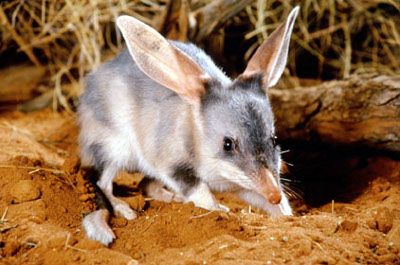Greater Bilby
Category: Marsupial

Facys about Greater Bilby. "Scientific name for Greater Bilby is Macrotis lagotis". The Greater Bilby is a breed of night-time omnivorous animal that hails from Australia. These breeds belong to the Peramelemorphia family, and they are largely found in dry areas of central Australia. However, currently, the range and population of the Greater Bilby breed are in decline.
Appearance of Greater Bilby
The Greater Bilby appears with extremely long ears and has the features of elongated Bandicoot muzzle. The Greater Bilby appear with a body length, ranging from 11 3/8 to 21 5/8 inches (29 to 55 cm). The Greater Bilby have an elongated tail, larger ears, and softer, shiny fur. The fur of these breeds is blue-grey in color with tan patches and is very malleable and their tail is black and white in color with a separate crest. The Greater Bilby has thick claws and strong forelimbs. The Greater Bilby is capable of having the better heeding capability when compared to other breeds due to its big-size ears. These claws enable them to excavate for food and make deep holes. The male Greater Bilby breed is bigger than the female one and carries a body weight of 5.3 pounds (2.4 kg) and go up to a maximum weight of 8.2 pounds (3.7 kg) in captivity. The smaller female breeds carry a body weight between 1.7 to 2.4 pounds (0.8 to 1.1 kg).
Behavior of Greater Bilby
Greater Bilbies are extremely motile varieties when it comes to foraging, with males traveling on an average of 3.1 miles (5 km) between burrows and females traveling .9 miles (1.5 km) between burrows. The difference in female and male Greater Bilby motility is probably owing to the fact that males are habitually looking for mates and require thinking only about them, whereas the female ones are responsible for their young and must effort to support them
Diet of Greater Bilby
The Greater Bilby breeds are night-time omnivores that have no necessity to drink water because they get the required moisture from their food. The Greater Bilby, feed on pests and their larvae, spiders, seeds, bulbs, fungi, fruit, and very tiny animals.
The average lifespan of the Greater Bilby breed is about five years.

 Back To Category Marsupial
Back To Category Marsupial